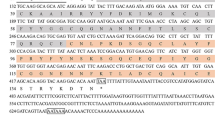Abstract
An antibacterial protein was purified from acidified gill extract of a bivalve mollusk, the American oyster (Crassostrea virginica). Protein isolation was best accomplished by briefly boiling the tissues in a weak acetic acid solution. Adding protease inhibitors while boiling did not have a major effect on activity recovery. In contrast, use of only protease inhibitors (without boiling) resulted in virtually no recovery of this activity. The amino acid sequence of this antibacterial protein was identified as a histone H2B and was designated cvH2B. cvH2B had potent activity against gram-negative bacteria, including the human pathogens Vibrio parahaemolyticus and Vibrio vulnificus, which commonly reside in oyster tissues. We estimated that the concentration of this protein was well within the concentration that was inhibitory to these bacterial pathogens in vitro. This is the first report of the antimicrobial function of histone H2B from any mollusk.




Similar content being viewed by others
References
Bowdish DME, Davidson DJ, Hancock REW (2005) A re-evaluation of the role of host defense peptides in mammalian immunity. Curr Protein Pept Sci 6:35–51
Brinkmann V, Reichard U, Goosmann C, Fauler B, Uhlemann Y, Weiss DS, Weinrauch Y, Zychlinsky A (2004) Neutrophil extracellular traps kill bacteria. Science 303:1532–1535
Brun NT, Ross NW, Boghen AD (2000) Changes in the electrophoretic profiles of gill mucus proteases of the eastern oyster Crassostrea virginica in response to infection by the turbellarian Urastoma cyprinae. J Invertebr Pathol 75:163–170
Fernandes JMO, Kemp GD, Molle MG, Smith VJ (2002) Anti-microbial properties of histone H2A from skin secretion of rainbow trout, Oncorhynchus mykiss. Biochem J 368:611–620
Genthner FJ, Volety AK, Oliver LM, Fisher WS (1999) Factors influencing in vitro killing of bacteria by hemocytes of the eastern oyster (Crassostrea virginica). Appl Environ Microbiol 65:3015–3020
Hiemstra PS, Eisenhauer PB, Harwig SSL, van den Bareselaar MT, van Furth R, Lehrer RI (1993) Antimicrobial proteins of murine macrophages. Infect Immun 61:3038–3046
Kawasaki H, Isaacson T, Iwamuro S, Conlon JM (2003) A protein with antimicrobial activity in the skin of Schlegel's green tree frog Rhacophorus schlegelii (Rhacophoridae) identified as histone H2B. Biochem Biophys Res Commun 312:1082–1086
Kim HS, Cho JH, Park HW, Yoon H, Kim MS, Kim SC (2002) Endotoxin-neutralizing antimicrobial proteins of the human placenta. J Immunol 168:2356–2364
Koryakov DE (2006) Histone modification and regulation of chromatin function. Russ J Genet 42:970–984
Noga EJ, Silphaduang U, Park NG, Seo JK, Stephenson J, Kozlowicz S (2009) Piscidin 4, a novel member of the piscidin family of antimicrobial peptides. Comp Biochem Physiol B 152:299–305
Olafsen JA, Mikkelsen HV, Glever HM, Hansen GH (1993) Indigenous bacteria in hemolymph and tissues of marine bivalves at low temperatures. Appl Environ Microbiol 59:1848–1854
Oliver JD (2006) Vibrio vulnificus. In: Thompson FL, Austin B, Swing J (eds) Biology of Vibrios. American Society For Microbiology Press, Washington
Palic D, Ostojic J, Andreasen CB, Roth JA (2007) Fish cast NETs: neutrophil extracellular traps are released from fish neutrophils. Dev Comp Immunol 31:805–816
Parseghian MH, Luhrs KA (2006) Beyond the walls of the nucleus: the role of histones in cellular signaling and innate immunity. Biochem Cell Biol 84:589–604
Patat SA, Carnegie RB, Kingsbury C, Gross PS, Chapman R, Schey KL (2004) Antimicrobial activity of histones from hemocytes of the Pacific white shrimp. Eur J Biochem 271:4825–4833
Pelon W, Luftig RB, Johnston KH (2005) Vibrio vulnificus load reduction in oysters after combined exposure to Vibrio vulnificus-specific bacteriophage and to an oyster extract component. J Food Prot 68:1188–1191
Richards RC, Oneil DB, Thibault P, Ewart KV (2001) Histone H1: an antimicrobial protein of Atlantic salmon (Salmo salar). Biochem Biophys Res Commun 284:549–555
Robinette D, Wada S, Arroll T, Levy MG, Miller WL, Noga EJ (1998) Antimicrobial activity in the skin of the channel catfish Ictalurus punctatus: characterization of broad-spectrum histone-like antimicrobial proteins. Cell Mol Life Sci 54:467–475
Rose FRAJ, Bailey K, Keyte JW, Chan WC, Greenwood D, Mahida YR (1998) Potential role of epithelial cell-derived histone H1 proteins in innate antimicrobial defense in the human gastrointestinal tract. Infect Immun 66:3255–3263
Sellos D (1985) The histones isolated from the sperm of the oyster, Crassostrea gigas. Cell Differ 17:183–192
Seo JK, Crawford JM, Stone KL, Noga EJ (2005) Purification of a novel arthropod defensin from the American oyster, Crassostrea virginica. Biochem Biophys Res Commun 338:1998–2004
Silphaduang U, Hincke MT, Nys Y, Mine Y (2006) Antimicrobial proteins in chicken reproductive system. Biochem Biophys Res Commun 340:648–655
Su Y-C, Liu C (2007) Vibrio parahaemolyticus: a concern of seafood safety. Food Microbiol 23:74–81
Thompson JD, Gibson TJ, Plewniak F, Jeanmougin F, Higgins DG (1997) The ClustalX windows interface: flexible strategies for multiple alignments aided by quality analysis tools. Nucleic Acids Res 25:4876–4882
Tincu JA, Taylor SW (2004) Antimicrobial peptides from marine invertebrates. Antimicrob Agents Chemother 48:3645–3654
Wang Y, Griffiths WJ, Jornvall H, Agerberth B, Johansson J (2002) Antimicrobial peptides in stimulated human granulocytes. Characterization of ubiquitinated histone H1A. Eur J Biochem 269:512–518
Xue Q-G, Schey KL, Volety AK, Chu FL, La Peyre JF (2004) Purification and characterization of lysozyme from plasma of the eastern oyster (Crassostrea virginica). Comp Biochem Physiol 139B:11–25
Zhang L, Eugeni EE, Parthun MR, Freitas MA (2003) Identification of novel histone post-translational modifications by peptide mass fingerprinting. Chromosoma 112:77–86
Acknowledgments
This work was supported by grant NA16-RG-2251 (R/AF-43 and R/AF-45) from the National Sea Grant College Program, National Oceanic and Atmospheric Administration to the North Carolina Sea Grant College Program (EJN), grant NA16-RG-2251 (BR-01) from the National Sea Grant College Program (Marine Biotechnology Program; EJN), North Carolina Fishery Research Grant Project #06-AM-03 (EJN), and the National Research Initiative of the USDA Cooperative State Research, Education and Extension Service, grant number #2006-35204-17508 (EJN, JKS) and USDA Agricultural and Food Research Initiative, grant number 2009-03571 (EJN, JD Oliver).
Author information
Authors and Affiliations
Corresponding author
Rights and permissions
About this article
Cite this article
Seo, JK., Stephenson, J., Crawford, J.M. et al. American Oyster, Crassostrea virginica, Expresses a Potent Antibacterial Histone H2B Protein. Mar Biotechnol 12, 543–551 (2010). https://doi.org/10.1007/s10126-009-9240-z
Received:
Accepted:
Published:
Issue Date:
DOI: https://doi.org/10.1007/s10126-009-9240-z




